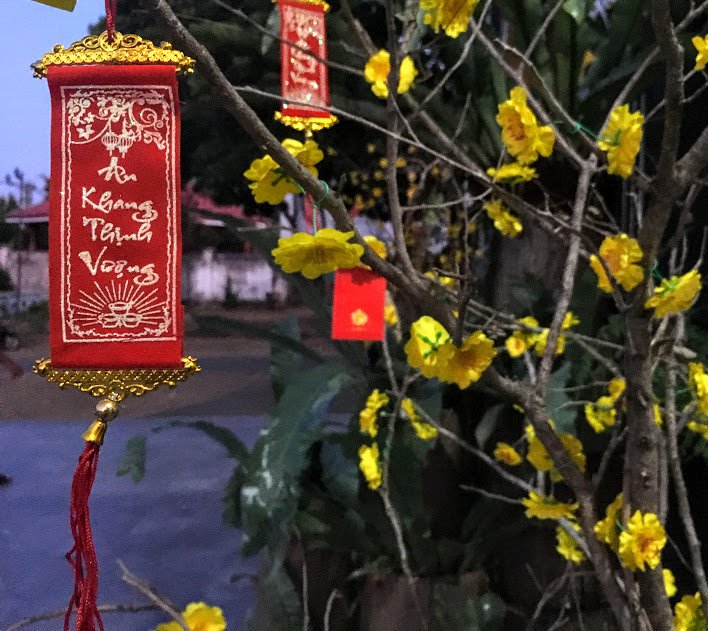
Beyond contest, the Lunar New Year is the biggest holiday in Vietnam. This year the holiday (called “Tết Nguyên Đán,” or “Tết” for short) ran approximately February 13th-23rd. The dates change every year depending on the lunar calendar. Preparations for the holidays began weeks in advance, with red envelopes and decorations going on sale as early as December, and songs about the arrival of spring looping from taxi radios to shop aisles across Ho Chi Minh City. Potted fruit and apricot flower trees graced business lobbies and home entries. By early February, golden flower petals drifted down from the tall trees lining city streets, as if nature also wanted to get in on the celebration.
Several friends invited me to join their families for the holiday. Tết is the only time each year when many city migrants get enough time off from work or school to visit home, so their invitations took me to all three distinct regions of the country. Over 22 total hours of journey time, I took buses, motorbikes, trucks, and airplanes through Vietnam’s southern ports, misty north, and rolling mountains of the central highlands. I tried to join as many friends as I could, while also taking advantage of opportunities to meet monastics who had returned to their home pagodas amidst otherwise busy travel schedules.
Tết is very much a time for two things: family and food. I tagged along on visits with grandparents, aunts, uncles, siblings, cousins, second cousins, and extended family members whose distant ties couldn’t quite be remembered, but who were still family, after all. At each house we visited, we stayed for snacks of sunflower seeds, pumpkin seeds, dried coconut, ginger, fruit, and candy; exchanged envelopes of lucky money to seed fortune in the new year; and chatted merrily until someone swept us off to another home. I have never eaten so much good food in my life!
As a time of significant symbolic and astrological transitions, the Lunar New Year is also imbued with religious meaning and practices. When visiting my friend in the south, we went to a fortune teller who gave us advice on how to attract success in the year ahead. The augur offered suggestions on everything from beauty tips, relationships, colors to wear, and days to visit Buddhist pagodas to maximize the spiritual efficacy of our prayers. In the north, another friend and I bundled up at midnight to rush down to the hamlet pagoda for a “night watch” ceremony, where the oldest man in the village welcomed the year with an offering that was followed by a community feast of sticky rice, chicken, and beer. Afterward, my friend’s grandfather rushed home to be the first person to arrive at their house – as the first person to enter a home on the new year influences the luck and tone of the whole year. In the central region, when the days of the new year were coming to a close, my friend’s family excused themselves after dinner to visit church grounds and say farewell to the family ancestors. Tết is also a time when spirits come closer to the world of the living, truly bringing family together across even the veil of death.
New Year traditions in Vietnam vary widely across regions, families, and households. If I learned anything during my travels, it is that there is no single “Tết,” but perhaps the incredible joy and energy of the holiday is generated precisely through the abundance of activities, rituals, and gatherings. I was honored to spend these days with so many welcoming families and strengthen my friendships with those I visited. As one friend’s grandmother said, “Spending a night at a home is like spending a year together.” Following her words, I gained many years of friendship through sharing these special days of Tết.
---------------------------------------------
Contact Information
